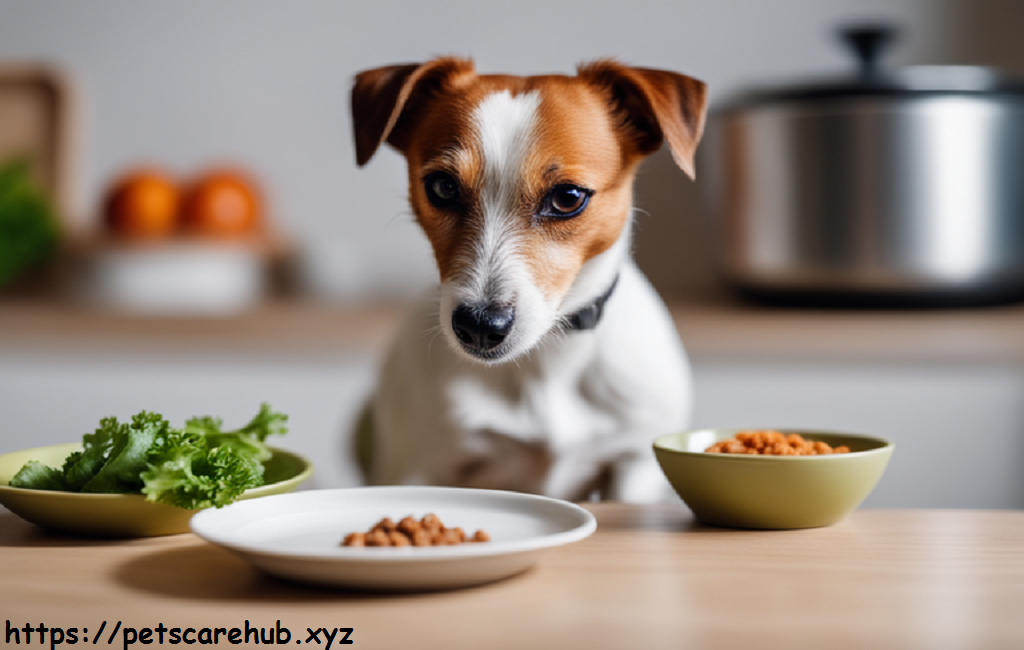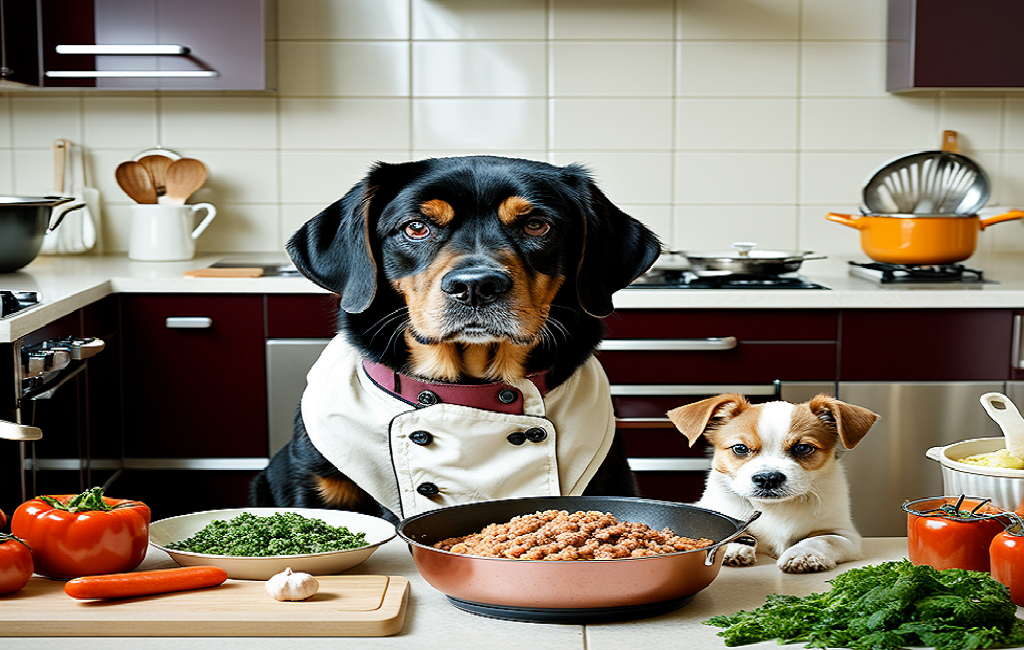People who love dogs, pay attention! Have you ever seen your furry friend scratching nonstop, having stomach problems, or even getting ear infections all the time?
Now, before you say it’s because of the seasons or those pesky fleas, have you thought that your dog might have food allergies?
Yes, just like people, dogs can become allergic to certain foods, which can be very bad for their health. In this helpful blog post, we’ll go over everything you need to know about dog food allergies so you can spot and take care of these annoying issues in your furry friends. So get a snack (for yourself!) and come with us as we figure out what Fido needs to eat and how to make him healthy again.

Introduction of Understanding Dog Food Allergies and Sensitivity:
We want the best for our animal friends because we own them. Not only do we feed them, but we also walk them and give them lots of love and care. No matter how hard we try, though, dogs can still have health problems that leave us scratching our heads. Food allergies are a common cause that is often forgotten.
Food allergies in dogs are becoming a bigger problem for both pet owners and vets. It can be hard to figure out which dog food is best for your dog because there are so many choices on the market. Some food allergies may show up right away after eating a new food, while others may not show up for weeks or even months.
As we go through this piece, we will learn more about dog food allergies. We will talk about what causes dogs to be sensitive to certain foods, how to tell if your dog might have an allergy, and most importantly, how to deal with these sensitivities so that your dog stays healthy and happy.
So why do some dogs become allergic to certain foods? Just like in people, some foods in dogs’ food can make their immune systems respond. Itching, stomach problems, and skin discomfort are some of the signs that happen when these ingredients are in the body.
It is important to tell the difference between a dog’s food allergies and sensitivity. Food allergies is a reaction from the immune system, while a sensitivity just means the dog has trouble eating the food, which can lead to stomach problems. Both can make your dog uncomfortable and hurt their health, but you need to know which one your pet is having to treat the problem properly.
It can be hard to tell if a dog has a food allergies because the signs often look like those of other health problems. A lot of scratching, hair loss, skin redness or itching, stomach problems like diarrhea or vomiting, and ear infections that won’t go away are all typical signs. If any of these things happen to your dog, you might want to think about whether they have a food allergies.
Taking care of dogs with food allergies takes time and effort. The best way to find out which ingredient causes your dog’s reaction is to take out possible allergens from their food and then add them back in one at a time. Your vet may also suggest special or limited ingredient foods to help your dog feel better.
In conclusion, every cat owner needs to know about dog food issues. If we know what causes allergies and how to spot them in our pets, we can make sure they stay healthy and happy for years to come. So let’s start this journey of learning and make sure our dogs do well!
An Introduction to Allergies to Dog Food
You could say that dogs are like family to us, and we want to make sure they are healthy and well cared for just like any other family member. This means giving them a healthy, well-balanced meal that meets their nutritional needs. But, just like people, dogs can get food allergies or sensitivities that can be painful and cause health problems if they are not taken care of properly.

We will talk about what dog food allergies are, how they happen, and the most common signs to look out for in this part. Pet owners who understand these key points will be able to spot signs that their furry friends might have food allergies and take the steps needed to treat them.
So what are food allergies in dogs?
When a dog’s immune system responds badly to certain ingredients in their food, this is called a food allergies. When an allergen (something that causes an allergic reaction) is eaten by a dog, it releases histamines, which cause swelling and other unpleasant symptoms.
For intolerances or sensitivities, stomach problems happen because of having trouble breaking down certain foods. Allergies, on the other hand, are caused by an immune reaction, which makes them worse and could be life-threatening if not addressed.
How do dogs get allergies to certain foods?
Not a single reason has been proven for why some dogs have food issues and others do not. Some experts think that genes play a part. This means that some breeds may be more likely to have problems with certain ingredients, while others may not have any issues at all.
Some people also think that giving puppies certain things too early in their lives could make them more likely to develop food allergies. In the same way, some experts say that giving the same kind of food for a long time may also make food allergies worse.
What are some of the most common signs of a dog food allergies?
Different dogs may show different signs, but these are the most usual ones:
Irritation of the skin: Dogs may get redness, itching, and even hair loss on their face, paws, underarms, and thighs.
Digestive problems: throwing up, diarrhea, or gas can also be signs of a food allergy.
Inflammation or illnesses in the ears: Because of allergies, the body makes too much wax and bacteria builds up.
Licking or biting at paws all the time.
If you don’t treat these symptoms, they could get worse and lead to more major health problems, like skin or ear infections that won’t go away.
Conclusion:
Dogs often have problems with food allergies, which can be painful and even cause health problems if they are not taken care of properly. Knowing the signs and taking the right steps, like finding and staying away from ingredients that cause the symptoms, can help ease your dog’s pain. If you think your dog might have a food allergies, you should take him or her to the vet to get a good diagnosis and treatment. Overall, the best way to keep your dog healthy and happy is to give them a balanced diet and watch how they react to different things.
How to Tell If Your Dog Has Food Sensitivities
It can be hard to tell if a dog has a food allergies because their signs often look like those of other health problems. But there are some common symptoms and signs that could mean your dog is sensitive to certain foods. Any changes in your dog’s health or behavior should be noticed, and you should talk to your vet if you think your dog might have a food allergies.

1. Getting irritated skin and food allergies
One of the most common signs that a dog is sensitive to food is skin rashes or allergies. If your dog scratches, bites, or licks themselves all the time, it could mean they are allergic to something in their food. Another thing to look for is skin that is red, bumpy, rashes, or has hot places.
2. Trouble Digesting
Dogs with digestive problems like vomiting, diarrhea, gas, bloating, or not going to the bathroom can also have a food allergies. Watch out for changes in your dog’s bathroom habits or signs that they may be in pain after eating.
3. Long-Term Ear Infections
If your dog gets ear infections often and they don’t go away even after the vet treats them, it could be because of a food allergies. Most of the time, these ear infections are caused by too much yeast, which can be brought on by certain foods they eat.
4. Problems with breathing
People who are sensitive to certain foods may also have breathing problems, like sneezing, coughing, wheeze, or trouble breathing. Some people with these symptoms may also have runny or stuffy noses.
5. Lack of energy and lethargy
It’s possible that your dog is sensitive to certain foods if it isn’t as alert and playful as normal. Dogs that are sensitive to certain foods may also be tired, lack energy, or look like they are in pain when they walk or run.
6. Skin and coat in bad shape
It’s possible for food allergies to hurt your dog’s skin and hair, making them look dull, dry, or flaky. This could be because of a reaction to their food if their hair looks bad or if they are losing a lot of fur.
7. Changes in behavior
Dogs with food allergies may act differently, such as becoming more aggressive, anxious, or restless, or cleaning themselves too much. You should keep an eye out for any strange behaviors in your dog and let your vet know if you see any.
It is important to remember that these signs can also mean that your dog has other health problems. It is best to talk to a vet to get an accurate report and learn about the best ways to treat your pet’s condition. To find out if your dog is sensitive to any foods, your vet may suggest an elimination diet or allergic tests. Even if your dog is sensitive to certain foods, it can still live a healthy and happy life with the right care and labeling.
Ingredients that are commonly used that can cause allergic reactions
Food allergies in dogs can be annoying and scary for their owners. You should learn about the chemicals that can cause an allergic reaction so that you can choose the right food for your dog.

Some of the most common things that can make dogs sick are listed below:
1. Dairy Products: Some dogs, like some people, can’t handle lactose, which means they can’t eat dairy products properly. This can make your stomach hurt, your skin itch, and cause other food allergies reactions.
2. Wheat and Gluten: As fillers or binders, wheat and gluten are found in a lot of industrial dog food. But these ingredients are known to be allergens for some dogs, which can make their guts swell and cause skin problems like rashes, itching, and hair loss.
3. Corn: Another filler that is often found in dog food that can make some dogs allergic is corn. Dogs don’t have the right enzymes to properly break down corn, which can make their stomachs upset and skin irritate them.
4. Protein: There is a lot of protein in dog food that comes from soy, but many cats are allergic to it. It could make your stomach hurt or give you skin responses like spots or burning.
5. Beef: One of the most common things that make dog allergies worse is beef. It could be because of alpha-galactosidase, a protein found in beef, or because drugs are given to animals and can get into their meat.
6.Bacon fat and sodium nitrate: We all love the taste of bacon, but dogs shouldn’t eat the chemicals and fillers that are used to make bacon fat and sodium nitrate. They can make you feel like you have allergies by making your skin itch, giving you stomach problems, or even hurting your kidneys.
7. Chicken: Chicken is often used in dog food, but some dogs may be allergic to it. Some dogs might be allergic to chicken protein or the drugs that chickens are given, which can get into their meat.
8. Eggs: Eggs are another type of protein that is often found in dog food, but some dogs are allergic to them. Egg allergies are not as common as other food allergies, though.
9. Fish: Fish can be good for dogs because it has nutrients, but some cats are afraid of it. It is important to keep your dog away from all kinds of fish if it is allergic to them, like salmon, tuna, and whitefish.
If you think your dog might have a food allergies you should take them to the vet so they can do the right tests and make a diagnosis. They can help you figure out what ingredients to stay away from and how to pick the best food for your pet friend’s needs.
How to Find Out If Your Dog Is Allergic to Dog Food:
It can be hard and take a lot of time to figure out if your dog has a food allergies, but it is very important to find the exact ingredients that are making your pet sick. You can use a number of tools and tests to help you figure out if your dog has a food allergies. We will talk more about these below.

1. The Elimination Diet is the best way to tell if your dog has a food allergies. During the process, you have to stop giving your dog foods that could be allergens, like beef, chicken, wheat, and cheese. For 8 to 12 weeks, your vet will tell you to feed your dog a new protein source (one that it has never eaten before) along with carbs like sweet potatoes or rice. If your dog’s symptoms get better during this time, it’s possible that they are allergic to one of the ingredients that were taken out. To be even more sure of the diagnosis, you can try adding each item again one at a time and see what happens.
2. As part of blood tests, the amount of certain antibodies in the blood that show an allergic reaction is measured. But these tests aren’t always accurate because they often give fake results and can’t tell the difference between real allergies or sensitivities.
3. A test called intradermal skin testing puts small amounts of allergens under your dog’s skin to see if they cause an allergic response. People think it’s more accurate than blood tests, but it can be pricey and some dogs may need to be sedated.
4. Trial of Food: A food trial is like an elimination diet, but it is done in a controlled setting while your vet watches. For 8 to 12 weeks, your dog will be fed a special diet (one with new protein and carbohydrate sources). If his symptoms get better, that means he has a food allergies.
5. There are now tests that claim to be able to tell if a dog has a food allergies by taking breath or hair samples and looking for signs of sensitivity. These tests have not been scientifically proven to be correct, though, so they shouldn’t be used to make a conclusion.
It is very important to work closely with your vet to correctly identify your dog’s food allergies and figure out the best way to treat them. They will also be able to rule out other possible reasons for your dog’s symptoms, like allergies to the surroundings or underlying health problems. With time and effort, you can figure out which foods are making your dog sick and find a diet that meets their nutritional needs while staying away from the foods that make them sick.
How to Take Care of Dog Food Allergies: Supplements and Dietary Changes
When dealing with your dog’s food allergies, changing their diet and giving them vitamins can help lower their symptoms and keep their health in good shape. Here are some ideas on how to put these plans into action:
1. Change your diet to one with few ingredients (LID)
A limited ingredient diet has only a few ingredients, which makes it easier to figure out which food is causing your dog’s reaction. These plans often use new protein sources, like duck, deer, or kangaroo, and stay away from common allergens, like beef and chicken. Talk to your vet to find out which LID device is best for your dog.
2. Don’t touch common allergens
As was already said, dogs often have problems with beef, chicken, wheat, soy, corn, and dairy. If you think that one of these might be making your pet’s food allergies signs worse, take them out of their diet completely.

3. Meals Made at Home
Some pet owners who have the time and resources can also help their dogs with food allergies by making meals at home that are specifically formulated for their dog’s needs. You can be sure that your pet gets all the nutrients they need because you have full control over what goes into their food.
4. Gradually add new sources of protein
Switching to a limited-ingredient or home-cooked diet might not be possible for you or your pet needs a more varied nutritional intake because of a health situation (like kidney disease), adding new protein sources gradually can be useful. This gives your dog’s digestive system time to get used to the new ingredient and lowers the chance that he or she will have a bad reaction.
5. Add Omega-3 Fatty Acids to Your Diet
Omega-3 fatty acids can help make allergic reactions in dogs less severe because they lower inflammation. These important fatty acids can be given to your dog by adding flaxseed or fish oil to its food.
6. Take probiotic supplements
Probiotic vitamins can help dogs with food allergies handle food better, fight off infections, and feel less pain. Talk to your vet to find out which bacteria pill will work best for your pet.
7. Try herbal cures
Herbal treatments like licorice root, chamomile, and nettle may help dogs with food allergies because they relax muscles and reduce swelling. Nevertheless, it is very important to talk to your vet before giving your dog any natural medicines.
8. Keep an eye on your dog’s progress
It is very important to keep a close eye on your dog’s growth after giving him vitamins or changing his food. Keep track of any changes in their symptoms and talk to your vet about them so that you can make any necessary changes.
Keep in mind that dealing with a dog’s food allergy is a process of trial and error. Making changes to your pet’s food and giving them pills may take some time to find the best mix for them. It’s important to be consistent and patient, and talking to your vet is the best way to make a treatment plan that fits your dog’s needs.
What dogs with food allergies need to eat to stay healthy
Dogs that are sensitive to certain foods need a special diet to help them deal with their situation. People who feed these dogs certain foods may give them bad responses, like skin irritations, extreme itching, and stomach problems. To make sure their dogs have a balanced and healthy diet, parents of dogs with food allergies should know what nutrients these dogs will need.
1. Find out what the food sensitivity is
It is very important to figure out which ingredient or chemicals are making your dog sensitive before you make any changes to his food. This can be done with elimination diets or by having a doctor do allergy tests. Once you know what’s causing the problem, you can start choosing things that are safe for your dog based on his allergies.

2. Source of Protein
For dogs, protein is an important ingredient that should make up a big part of their food. If your dog has food allergies, you should choose protein sources that are easy for them to digest and less likely to make them sick. Instead of beef or chicken, which are more likely to cause food allergies in dogs, some popular choices are lamb, deer, duck, or fish.
3. Sugars and carbs
Carbohydrates help keep your dog’s gut system healthy and give them energy for their daily tasks. That being said, not all starches are the same when it comes to helping dogs with food allergies. Many people can handle complex carbs like sweet potatoes, peas, and barley better than simple carbs like corn or wheat.
4. Stay away from common allergens
Some sources of protein and carbs may not be safe for dogs with food allergies, and some chemicals or pesticides that are popular in commercial dog foods may also need to be avoided. Some of these are soy, dairy, corn, and other common allergens, as well as fake colors, flavors, and chemicals.
5. Important Fatty Acids
Dogs need omega-3 fatty acids to keep their skin and hair healthy. These acids can also help reduce inflammation, which may ease some of the signs of food allergies. Fish oil or flaxseed are great sources of omega-3s, so look for things that are made with them.
6. Taking extra vitamins and minerals
It is important to make sure that dogs with food allergies are still getting all the vitamins and minerals they need when they switch to a limited ingredient diet. Talk to your vet about any possible nutrient shortages in your dog’s new food, and if they are, think about giving your dog vitamins.
Before making big changes to your dog’s diet, you should always talk to a vet, especially if you know that your dog is sensitive to certain foods. A trained professional will be able to help you choose the best foods for your dog’s preferences. If your dog has food allergies, make sure you read the labels carefully and choose high-quality, well-balanced meals to give them the best nutrition possible while also handling their allergies.
Which is better for dogs with allergies: homemade or store-bought food?
One of the most important choices a dog owner has to make when dealing with food allergies in their dog is whether to feed their dog homemade food or food from the store. It can be hard to figure out which type of food is best for your pet friend because there are so many choices on the market. We will talk about the pros and cons of both homemade and store-bought dog food for allergies in this part. This will help you decide what is best for your dog.
Dogs with allergies can eat homemade food:
A lot of dog owners make their own food for their dogs because they can control what goes into it. You can carefully choose each item with this choice, and you can even make the diet fit your dog’s allergens. Also, homemade dog food usually only has natural, whole ingredients and doesn’t have any of the chemicals or preservatives that are in store-bought dog food.
But making a home-cooked meal that is balanced and full of nutrients can be hard and take a lot of time. It takes a lot of study on what dogs should eat and regular tracking and changes based on your dog’s needs. Also, some products, like organ foods or extras like calcium and vitamins, might not be easy to find at your neighborhood grocery store.
Also, it’s important to remember that not all foods made for humans are safe for dogs. Some common ingredients used in human food can actually be dangerous or toxic to dogs. For example, you should stay away from all onions, garlic, grapes or raisins, chocolate, and avocados. You should work closely with a veterinary nutritionist to make sure that your dog’s nutritional needs are met if you decide to feed them home-cooked food.
Foods you can buy for dogs with allergies:
Pet owners who don’t have the time or means to make their own meals may find that store-bought diets are more convenient and give them peace of mind. These diets are usually made by people who know a lot about feeding animals. They come in different forms, like dry kibble, canned food, or freeze-dried raw food. They are also put through a lot of tests and quality checks to make sure they meet the nutritional standards for dogs.
When it comes to commercial meals, there are also choices that are made just for dogs with allergies. Most of the time, these have different protein sources (like lamb or fish) and carbs (like sweet potatoes or peas) that are less likely to make dogs allergic. But it’s important to remember that even safe foods might have ingredients that your dog is allergic to, so it’s important to read the list of ingredients very carefully every time.
Store-bought meals can be convenient and provide proper nutrition for dogs with allergies. However, some brands may use fillers or lower quality products that don’t give the dog the nutrients it needs for good health. You should do some study and pick a good brand that has a good name and uses pure, whole products.
For the most part, both homemade and store-bought foods can be good for dogs with allergies. You have more control over the ingredients in a homemade diet, but you need to do study and plan ahead carefully. While store-bought meals may be easier, it is very important to read the ingredient lists very carefully to make sure they are safe for your dog’s allergens. Whichever choice you choose, speaking with a doctor or veterinary dietitian can help ensure your dog is getting a healthy and nutritionally full meal that meets their unique needs.
Tips for Introducing New Foods:
1. Start with small amounts: When adding a new food to your dog’s diet, it is important to start with small amounts and gradually increase the number over time. This will help your dog’s digestive system to adjust and lower the risk of any bad effects.
2. Choose high-quality ingredients: Opt for safe or limited ingredient meals that are made especially for dogs with food allergies. These recipes often contain high-quality proteins such as lamb, duck, or fish that are less likely to cause an allergic response.
3. Introduce one new food at a time: It is important to introduce only one new food at a time and wait for 7-10 days before adding another new item to the diet. This will help you discover which foods are causing possible problems if your dog has a bad response.
4. Gradually mix in the new food: Instead of moving your dog’s entire meal to the new food, gradually mix it in with their current food over several days until they are solely eating the new formula. This will give their body time to change and reduce any possible stomach problems.

5. Keep track of ingredients: Keep track of all the ingredients in each new food you introduce so you can easily spot any possible allergens if your dog has a bad response.
6. Consider novel proteins: If your dog is allergic to popular proteins like chicken or beef, consider trying novel protein sources such as bison or kangaroo which may be less likely to cause allergies.
7. Monitor your dog’s reactions: Pay attention to any changes in your dog’s behavior or health after offering a new food. If you spot any bad responses, talk with your doctor and consider removing the new food from their diet.
8. Incorporate variety: To avoid boredom and ensure a healthy diet, it is important to incorporate variety into your dog’s food. This can include mixing up meats, putting in fresh fruits and veggies, and moving between different types of high-quality dog food.
9. Be patient: It may take time for your dog to adjust to new foods and tastes, so be patient and don’t get frustrated if they initially reject certain foods. Keep trying different options until you find what works for them.
10. Consult with a veterinarian: If you have concerns about introducing new foods to your dog, consult with your veterinarian for advice specific to your dog’s needs and health conditions. They can help guide you in finding the right foods for your pup.
